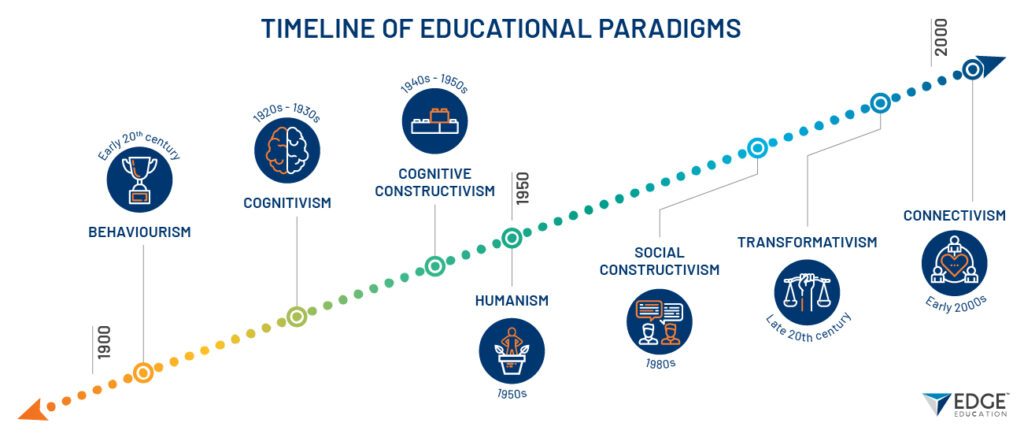In our previous article, we introduced seven educational paradigms that can serve as cornerstones for shaping your unique educational philosophy. In this follow-up, we delve deeper into these paradigms, exploring their origins, evolution and current applications in education. We also examine the intersections and connections between these paradigms, so as to provide you with a comprehensive understanding that can inform your teaching practice.
Let’s begin our exploration with behaviourism.
Behaviourism: Shaping behaviour through reinforcement
Behaviourism emerged in the early 20th century in response to the introspective and subjective methods of psychology that were dominant at the time (Western Governors University 1, 2020). Pioneered by researchers like John Watson and B. F. Skinner, behaviourism sought to analyse how environmental stimuli influence behaviour. These theorists suggested that behaviour could be predicted by observing the patterns of reinforcement and punishment that individuals experienced in response to their actions. In other words, behaviourists believe that ‘the things we experience and our environment are the drivers of how we act’ (Western Governors University 1, 2020). A popular example of this behaviourist learning is found in Pavlov’s experiment with dogs.
However, behaviourism has faced criticism in recent years, with many educators and psychologists arguing that it oversimplifies human behaviour and overlooks the role of internal mental processes in learning (Western Governors University 1, 2020; and Greenwood, 2020). Despite this criticism, behaviourism is still used in education – particularly through behaviour management strategies that are designed to shape student behaviour and establish a controlled learning environment (Western Governors University 1, 2020). This is done by encouraging positive behaviours (e.g. by rewarding students with added privileges) and discouraging negative ones (e.g. by removing privileges or punishing students). However, it is often integrated with other learning theories, like cognitivism, to create a more well-rounded approach to education.
Cognitivism: The power of mental processes
Cognitivism arose during the 1920s and 1930s as a counter to behaviourism (Michela, n.d.). Key theorists in the initial development of this paradigm include Edward Tolman, Wolfgang Kohler and Ivan Krechevsky. In contrast to behaviourism, which focuses on external stimuli, cognitivism underscores the importance of internal mental processes, such as perception, memory, and critical thinking in learning (Western Governors University 2, 2020).
In the context of education, cognitivists advocate for the creation of learning environments that facilitate active engagement and meaningful learning. Educators are encouraged to provide opportunities for students to connect new information with their existing knowledge and to reflect on their own thought processes (Western Governors University 2, 2020).
Today, cognitivism continues to play a significant role in education. It has heavily influenced instructional design – a field that is dedicated to devising effective learning experiences that promote the long-term retention of information. An example of a cognitivist instructional strategy is to encourage self-regulated learning ‘by providing opportunities for learners to control some aspects of their learning environment’ (Michela, n.d.).
Cognitive constructivism: Building knowledge through experience
Cognitive constructivism emerged from the broader cognitive revolution as a compelling alternative to behaviourism and cognitivism, highlighting the significance of mental processes and cognitive structures in human learning. The development of cognitive constructivism can be attributed to influential psychologists and philosophers like Jean Piaget and John Dewey, whose theories underscored the active role of students in constructing knowledge through meaningful experiences and interactions with their environment (Teaching for Transformation 1, n.d.).
In the educational context, cognitive constructivists advocate for the creation of interactive learning environments that promote active student participation (Mcleod, 2023). Educators are encouraged to provide students with opportunities to engage in meaningful learning experiences, such as problem-solving, inquiry-based learning and discovery learning. In this way, students create new knowledge by building on prior knowledge from their previous experiences (Teaching for Transformation 1, n.d.).
Today, cognitive constructivism remains a widely adopted learning theory. It has greatly influenced the development of constructivist teaching methods that position the student at the centre of the learning process. This encourages educators to design student-centred learning experiences that are interactive and conducive to critical thinking.
Social constructivism: The social element of learning
Social constructivism, another branch of constructivism, emerged in the 1980s. While cognitive constructivism focuses on how students construct new knowledge on the basis of prior knowledge, social constructivism focuses on the social element of learning, suggesting that knowledge is constructed through collaboration and social interaction (Teaching for Transformation 2, n.d.). Social constructivism evolved from the work of researchers such as Lev Vygotsky, Jean Lave and Etienne Wenger, who highlighted the importance of social interactions and cultural contexts in shaping students’ knowledge and understanding of the world (Teaching for Transformation 2, n.d.).
In education, social constructivism has been used to promote the idea that learning should be a collaborative process. Educators who subscribe to this paradigm are encouraged to create learning environments that promote social interaction, so as to enable students to work together to construct new knowledge (Mcleod, 2023). Group projects, peer tutoring and collaborative problem-solving are examples of social constructivist learning activities. The social constructivist paradigm is also evident in educational technologies that are designed to support collaborative learning; for example, online discussion forums and collaborative document editing tools that enable students to work together to construct knowledge in a virtual environment.
Humanism: Fostering individual growth and self-actualisation
In the 1950s, humanism emerged as a response to the prevailing theories of behaviourism and cognitivism. Visionaries like Abraham Maslow and Maria Montessori played instrumental roles in developing humanistic psychology, emphasising the importance of individual autonomy, self-directed learning and self-actualisation (Teaching for Transformation 3, n.d.).
In education, the humanist approach is used to advocate for the creation of nurturing and supportive learning environments that promote students’ personal growth (Baker et al., 2021). Educators are encouraged to provide opportunities for students to explore their own interests and passions, while cultivating critical thinking and problem-solving skills (Teaching for Transformation 3, n.d.).
Today, humanism continues to be a highly influential theory in education, and it has paved the way for student-centred approaches to learning, such as self-directed learning and self-evaluation (Teaching for Transformation 3, n.d.). These approaches emphasise students’ freedom of choice and autonomy. Additionally, humanism has contributed significantly to the development of social and emotional programmes that are designed to support students’ socio-emotional well-being and overall development (Baker et al., 2021).
Transformativism: Driving social change through education
Transformativism, a relatively recent educational paradigm, emerged in the late 20th century from a broader social justice movement aimed at addressing societal inequalities and injustices. Rooted in the work of critical theorists like Paulo Freire and bell hooks, transformativism emphasises creating socially just and equitable learning environments, empowering students to critically examine their experiences and challenge societal norms and power structures that perpetuate inequality.
Transformativists contend that learning extends beyond the acquisition of knowledge and skills; it involves transforming oneself and society. As such, this paradigm places a strong emphasis on social responsibility and recognises the need for education to address broader societal issues, such as inequality, discrimination and environmental degradation (Krikorian, 2020). In education, transformativist educators foster learning environments that encourage critical thinking, social action and personal growth (Teaching for Transformation 4, n.d.). They create opportunities for students to explore their own beliefs and values, thereby enabling them to develop a sense of agency and responsibility for driving both individual and social change.
Transformativism continues to wield significant influence in education today. It promotes diverse educational approaches, including service learning, community-based learning and global education. These approaches strive to bridge the gap between classroom learning and real-world issues, inspiring students to take tangible action to achieve positive change (Krikorian, 2020).
Connectivism: Harnessing technology for learning
Connectivism emerged in the early 2000s in response to the profound influence of technology and the Internet on our daily lives. It places a strong emphasis on connections, networks and the use of technology in shaping learning and knowledge construction. The development of connectivism can be attributed to George Siemens and Stephen Downes, who challenged traditional educational paradigms, arguing that they no longer adequately explain how knowledge is constructed and shared in the Digital Age. With the Internet and digital technology fundamentally transforming access to and the creation and sharing of knowledge, educators must adapt to these changes to create effective learning environments (Bates, 2015: 66).
In educational contexts, connectivists advocate for flexible, adaptive and personalised learning experiences. Educators foster learning environments that leverage technology and social networks, enabling students to connect with one another and collaborate on projects and ideas, and as such, be exposed to new knowledge (Bates, 2015: 66).
While still a relatively new theory, connectivism holds the potential to profoundly impact the future of education as technology continues to assume an increasingly central role in our lives. This approach has led to the promotion of various innovative approaches to learning and teaching, including online and blended learning, personalised learning and networked learning (Corbett, 2020).
The following figure provides an overview of when each paradigm emerged.
Intersection of educational paradigms
To develop an effective and well-rounded educational philosophy, you can draw on the strengths of several paradigms. Knowing where these paradigms intersect can help you to select the appropriate ones to integrate into your personal educational philosophy.
Despite their different perspectives, cognitivism and constructivism both acknowledge the active role of students in constructing knowledge, albeit from different angles. Cognitivism centres on mental processes such as attention, memory and problem-solving, while constructivism emphasises the influence of prior knowledge and experiences on shaping new learning.
Humanism and constructivism both underscore the significance of student-centredness and students’ unique experiences and needs. Humanism promotes self-directed learning and student autonomy, while constructivism emphasises the active construction of knowledge based on prior experiences and social interactions.
Transformativism and social constructivism both recognise the impact of social contexts and power relations on learning. While transformativism highlights the critical examination and transformation of social structures, social constructivism focuses on the role of social interactions and cultural contexts in constructing knowledge.
Similarly, connectivism and social constructivism both stress the importance of social connections and networks in learning. However, connectivism emphasises the role of technology in creating and navigating information networks, while social constructivism highlights the importance of collaborative activities, such as dialogue, negotiation and joint problem-solving, in constructing knowledge within a social context.
Understanding these education paradigms and their applications can help educators to refine their personal educational philosophies and craft effective learning environments. By considering the strengths and limitations of each paradigm, educators can adopt a more holistic and comprehensive approach to learning and teaching, thereby providing their students with diverse opportunities to learn, grow and thrive.
References
Baker, L. R., Phelan, S., Woods, N. N., Boyd, V. A., Rowland, P. and Ng, S. L. (2021), ‘Re-envisioning paradigms of education: towards awareness, alignment, and pluralism’. Advances in Health Sciences Education: Theory and Practice 26(3): 1045–1058.
Bates, A. W. (2015), Teaching in a Digital Age. Vancouver: Tony Bates Associates.
Corbett, F. (2020), ‘Connectivism and leadership: harnessing a learning theory for the digital age to redefine leadership in the twenty-first century’. Heliyon 6(1): 1–9.
Greenwood, B. (2020), ‘What is Behaviourism and How to Use it in the Classroom?’ The Satchel Blog [website] <https://blog.teamsatchel.com/what-is-behaviourism-and-how-to-use-it-in-the-classroom#:~:text=Behaviourism%20in%20the%20modern%20classroom&text=Rewarding%20students%20for%20working%20well,conditioning%20techniques%20championed%20by%20Skinner.> accessed 6 June 2023.
Krikorian, M. (2020), ‘Adult Learning and Critical Contemplative Pedagogy in Higher Education’. In Parson, L. and Ozaki, C. C. Teaching and Learning for Social Justice and Equity in Higher Education. Cham: Palgrave Macmillan, pp. 259–278.
Mcleod, S. (2023), ‘Constructivism Learning Theory & Educational Philosophy’. Simply Psychology [website] <https://www.simplypsychology.org/constructivism.html> accessed 7 June 2023.
Michela, E. ‘Cognitivism’. EdTech Books [website] <https://edtechbooks.org/studentguide/cognitivism> accessed 6 June 2023.
Teaching for Transformation 1 [website] ‘Cognitive constructivism’. <https://www.teachingfortransformation.com/cognitive-constructivism/#:~:text=The%20constructivist%20paradigm%20viewed%20knowledge,make%20sense%20of%20their%20experience.> accessed 7 June 2023.
Teaching for Transformation 2 [website] ‘Social constructivism’. <https://www.teachingfortransformation.com/social-constructivism/> accessed 7 June 2023.
Teaching for Transformation 3 [website] ‘Humanism’. <https://www.teachingfortransformation.com/humanism/> accessed 6 June 2023.
Teaching for Transformation 4 [website] ‘Transformative’. <https://www.teachingfortransformation.com/transformative/#:~:text=Learning%20in%20the%20transformative%20paradigm,both%20individual%20and%20social%20transformation.> accessed 6 June 2023.
Western Governors University 1 [website] (2020), ‘What is the behavioral learning theory?’ <https://www.wgu.edu/blog/what-behavioral-learning-theory2005.html#openSubscriberModal> accessed 6 June 2023.
Western Governors University 2 [website] (2020), ‘What is cognitive learning?’ <https://www.wgu.edu/blog/what-is-cognitive-learning2003.html> accessed 6 June 2023.
Western Governors University 3 [website] (2020), ‘What is the transformative learning theory?’ <https://www.wgu.edu/blog/what-transformative-learning-theory2007.html> accessed 6 June 2023.




